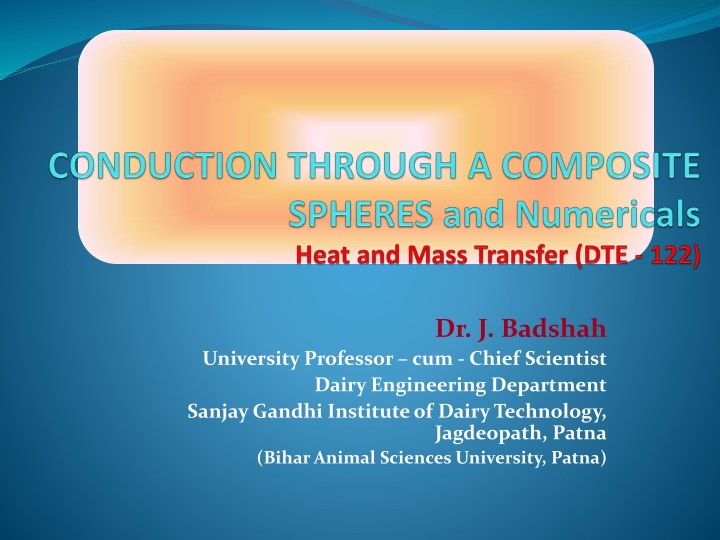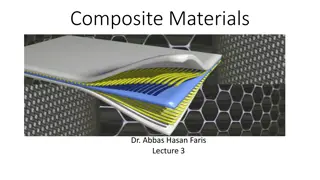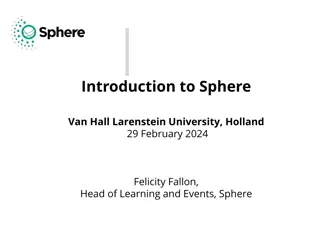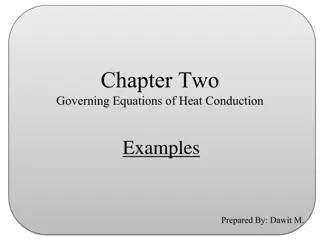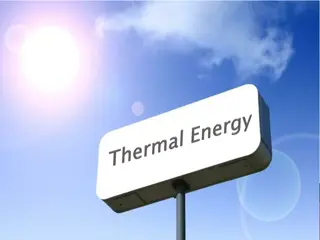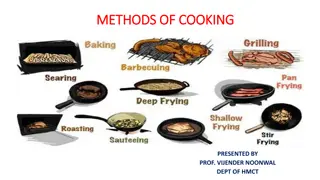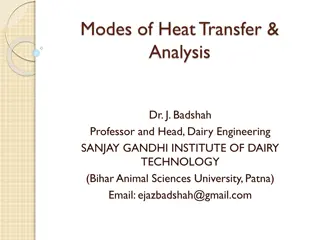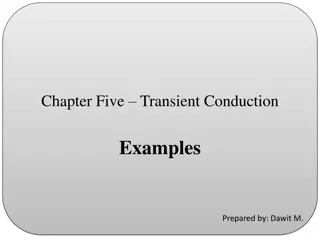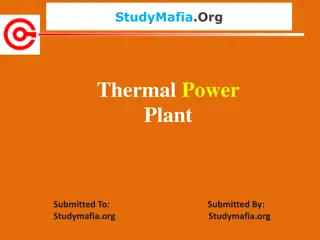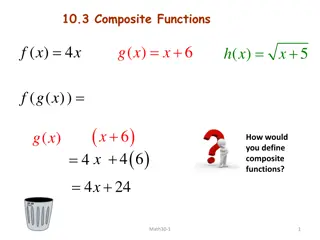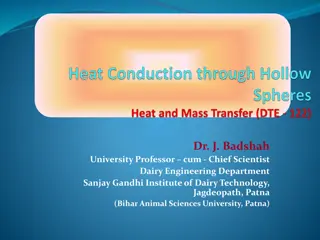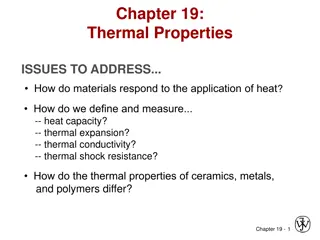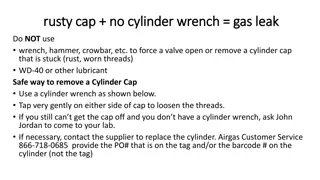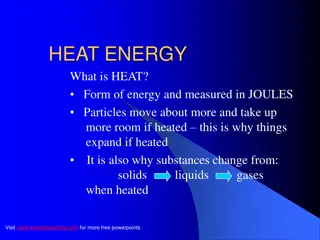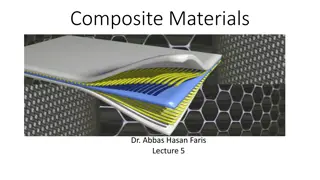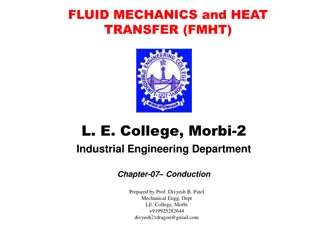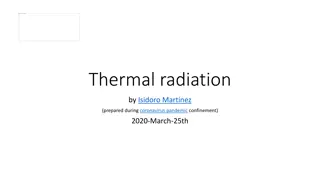Thermal Conduction Analysis in Composite Sphere and Cylinder
Dr. J. Badshah, a distinguished university professor and chief scientist, discusses thermal conduction through cylindrical walls and composite structures like spheres and cylinders. The analysis includes equations for heat transfer rates, numerical examples, and insights into critical insulation thickness. The content explores how temperature variations impact heat flow in these structures, offering valuable information for engineering applications.
Download Presentation

Please find below an Image/Link to download the presentation.
The content on the website is provided AS IS for your information and personal use only. It may not be sold, licensed, or shared on other websites without obtaining consent from the author.If you encounter any issues during the download, it is possible that the publisher has removed the file from their server.
You are allowed to download the files provided on this website for personal or commercial use, subject to the condition that they are used lawfully. All files are the property of their respective owners.
The content on the website is provided AS IS for your information and personal use only. It may not be sold, licensed, or shared on other websites without obtaining consent from the author.
E N D
Presentation Transcript
Dr. J. Badshah University Professor cum - Chief Scientist Dairy Engineering Department Sanjay Gandhi Institute of Dairy Technology, Jagdeopath, Patna (Bihar Animal Sciences University, Patna)
Conduction Through Cylindrical Wall Let us consider a Composite sphere of inner radius r1, outer first layer radius r2and outer second layer radius r3 .Let us assume K of the materials are constant. The inner hot fluid temperature as thf ,and outer face temperature of sphere as t1, Temperature at outer temperature of first layer as t2and second layer as t3 and tcfas temperature of cold fluid atmospheric air at extreme outer are held at constant values. In which, thecondition prevails as thf> t1> t2> t3> tcf. Therefore temperature varies only radially and we can assume that this radial direction is x-direction. Thus temperature field is one dimensional and the isothermal surfaces are spherical surfaces possessing a common axis with the sphere.
Conduction Through Composite Cylindrical Wall During steady state, the rate of heat transfer is given by Q = hhf4 (r1)2(thf- t1 ) = KA. 4 . r1r2(t1 - t2 )/(r2- r1) = KB. 4 .r2r3(t2 - t3 )/ (r3- r2) = hcf4 (r3)2(t3 - tcf) (thf- t1 ) = Q/ hhf4 (r1)2 (t1 - t2 ) = Q (r2- r1)/ KA 4 . r1r2 (t2 - t3 ) = Q (r3- r2) / KB 4 . r2r3 (t3 - tcf) = Q/ hcf4 (r3)2 On Addition, we have general equations for two layer case: Q = 4 (thf tcf)/ [ 1/ hhf.(r1)2+ (r2- r1)/ r1r2 .KA + (r3- r2)/r2r3. KB+ 1/ hcf.(r3)2] For nth layer case, the general equations is : Q= 4 (thf tcf)/ [ 1/ hhf.(r1 )2+ (n=1 to n=n){(r(n+1)- rn)/ rn. r(n+1).Kn}+ + 1/ hcf.(r(n+1))2]
Numerical on Composite sphere with convection coefficients A spherical shaped vessel of 1.4 m diameter is 90 mm thick. Find the rate of heat leakage, if the temperature difference between the inner and outer surfaces is 220 C. Thermal conductivity of the material of the sphere is 0.083 W/m . C. Solution: Rateof heat loss: r2= 0.7 m and r1= 0.7 90/100 = 0.61 m Q = (t1 t2)/ [(r2- r1) / KA4 . r1r2] Q = 220/ [(0.7 - 0.61) / 0.083 x 4 . 0.61 x 0.7 ] Q = 1088.67 Watt
CRITICAL THICKNESS OF INSULATION Insulation : To retard the to and fro heat Flow in boilers, Air Conditioning system, Refrigerators, Cold Stores etc. Critical Thickness: The thickness uptowhich heat flow increases and after which heat flow decreases is termed as Critical Thickness of insulation. Critical thickness of insulation for cylinder: Q = ( t1 - t2) (2 L)/ { ln (r2/ r1)/K + 1/ ho. r2} kcal/hr Q becomes maximum when denominator will be minimum. When differential of denominator with respect to r2 is equated to zero, the condition for minimum denominator or total resistance and maximum heat loss will be achieved:
CRITICAL THICKNESS OF INSULATION Q = (t1 tair)/ [ 1/ ho .(4 r2)2+ (r2- r1)/ r1r2 .4 K] On differentiation to get minimum denominator and maximum heat flow: d/dr2 [ 1/ ho .(4 r2)2+ (r2- r1)/ r1r2 .4 K]= 0 d/dr2 [ 1/ ho .(r2)2+ (1/K. r1- 1/K. r2)]= 0 1/ K. .(r2)2- 2/ ho (r2)3 = 0 (r2)3 .ho= 2 K . (r2)2 Critical Radius, r2 = 2K/ ho
CRITICAL THICKNESS OF INSULATION Considering r2 as variable: d/dr2[{ ln (r2/ r1)/K + 1/ ho. r2} = 0 1/k . 1/ r2 + 1/ ho(- 1/( r2)2 = 0 1/k - 1/ ho.R2 = 0 r2 (= rc) = K/ ho
Numericals on steam pipe without and with insulation An aluminium pipe carries steam at 110 C. The pipe (K = 185 W/m. C) has an inner diameter of 100 mm and outer diameter of 120 mm. The pipe is located in a room where the ambient air temperature is 30 C and the convective heat transfer coefficient between the pipe and air is 15 W/m2 C. Determine the heat transfer rate per unit length of pipewithout insulation. To reduce the heat loss from the pipe, it is covered with a 50 mm thick layer of insulation (K = 0.20 W/m. C). Determine the heat transfer rate per unit length from the insulated pipe. Assume that the convective resistance of the steam is negligible.
Numericals on steam Pipes Use the formula with convective coefficient on cold air side only: Case I- L = 1 meter, r1 = 0.05 m, r2 = 0.06 m Q = 2 L (thf tcf)/ [ln (r2/r1)/ KA + + 1/ hcf.r2] = 451.99 W/m Case II- L = 1 meter, r1 = 0.05 m, r2 = 0.06 m and r3 = 0.11 m Q = 2 L (thf tcf)/ [ ln (r2/r1)/ KA + ln (r3/r2)/ KB+ 1/ hcf.r3] Q = 138.18 W/ m
